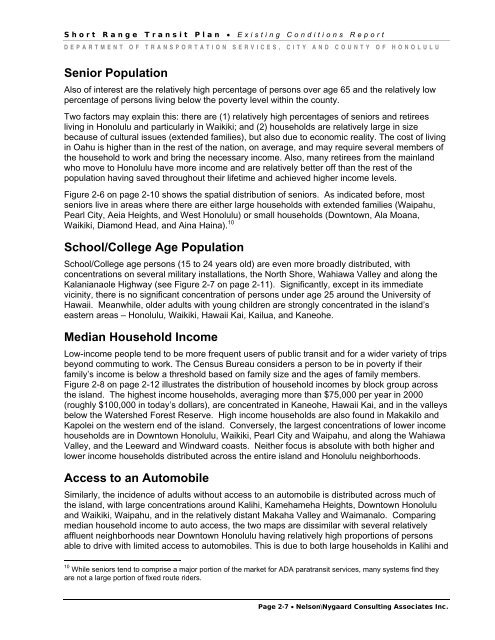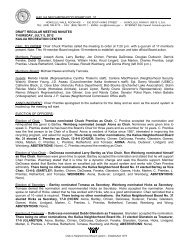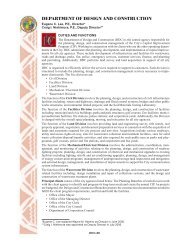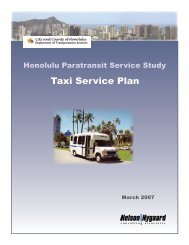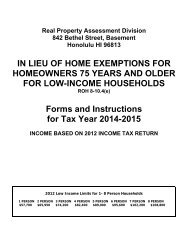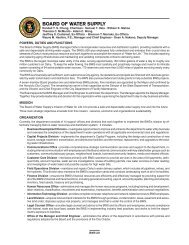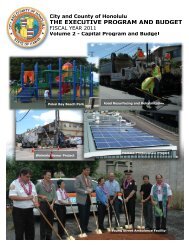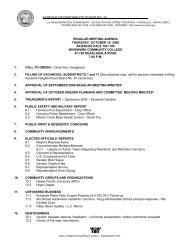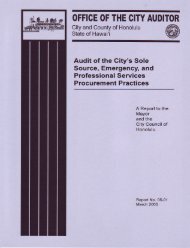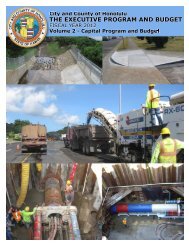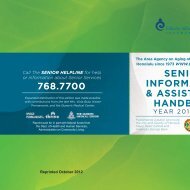Existing Conditions Existing Conditions Final - City & County of ...
Existing Conditions Existing Conditions Final - City & County of ...
Existing Conditions Existing Conditions Final - City & County of ...
Create successful ePaper yourself
Turn your PDF publications into a flip-book with our unique Google optimized e-Paper software.
Short Range Transit Plan • <strong>Existing</strong> <strong>Conditions</strong> ReportDEPARTMENT OF TRANSPORTATION SERVICES, CITY AND COUNTY OF HONOLULUSenior PopulationAlso <strong>of</strong> interest are the relatively high percentage <strong>of</strong> persons over age 65 and the relatively lowpercentage <strong>of</strong> persons living below the poverty level within the county.Two factors may explain this: there are (1) relatively high percentages <strong>of</strong> seniors and retireesliving in Honolulu and particularly in Waikiki; and (2) households are relatively large in sizebecause <strong>of</strong> cultural issues (extended families), but also due to economic reality. The cost <strong>of</strong> livingin Oahu is higher than in the rest <strong>of</strong> the nation, on average, and may require several members <strong>of</strong>the household to work and bring the necessary income. Also, many retirees from the mainlandwho move to Honolulu have more income and are relatively better <strong>of</strong>f than the rest <strong>of</strong> thepopulation having saved throughout their lifetime and achieved higher income levels.Figure 2-6 on page 2-10 shows the spatial distribution <strong>of</strong> seniors. As indicated before, mostseniors live in areas where there are either large households with extended families (Waipahu,Pearl <strong>City</strong>, Aeia Heights, and West Honolulu) or small households (Downtown, Ala Moana,Waikiki, Diamond Head, and Aina Haina). 10School/College Age PopulationSchool/College age persons (15 to 24 years old) are even more broadly distributed, withconcentrations on several military installations, the North Shore, Wahiawa Valley and along theKalanianaole Highway (see Figure 2-7 on page 2-11). Significantly, except in its immediatevicinity, there is no significant concentration <strong>of</strong> persons under age 25 around the University <strong>of</strong>Hawaii. Meanwhile, older adults with young children are strongly concentrated in the island’seastern areas – Honolulu, Waikiki, Hawaii Kai, Kailua, and Kaneohe.Median Household IncomeLow-income people tend to be more frequent users <strong>of</strong> public transit and for a wider variety <strong>of</strong> tripsbeyond commuting to work. The Census Bureau considers a person to be in poverty if theirfamily’s income is below a threshold based on family size and the ages <strong>of</strong> family members.Figure 2-8 on page 2-12 illustrates the distribution <strong>of</strong> household incomes by block group acrossthe island. The highest income households, averaging more than $75,000 per year in 2000(roughly $100,000 in today’s dollars), are concentrated in Kaneohe, Hawaii Kai, and in the valleysbelow the Watershed Forest Reserve. High income households are also found in Makakilo andKapolei on the western end <strong>of</strong> the island. Conversely, the largest concentrations <strong>of</strong> lower incomehouseholds are in Downtown Honolulu, Waikiki, Pearl <strong>City</strong> and Waipahu, and along the WahiawaValley, and the Leeward and Windward coasts. Neither focus is absolute with both higher andlower income households distributed across the entire island and Honolulu neighborhoods.Access to an AutomobileSimilarly, the incidence <strong>of</strong> adults without access to an automobile is distributed across much <strong>of</strong>the island, with large concentrations around Kalihi, Kamehameha Heights, Downtown Honoluluand Waikiki, Waipahu, and in the relatively distant Makaha Valley and Waimanalo. Comparingmedian household income to auto access, the two maps are dissimilar with several relativelyaffluent neighborhoods near Downtown Honolulu having relatively high proportions <strong>of</strong> personsable to drive with limited access to automobiles. This is due to both large households in Kalihi and10 While seniors tend to comprise a major portion <strong>of</strong> the market for ADA paratransit services, many systems find theyare not a large portion <strong>of</strong> fixed route riders.Page 2-7 • Nelson\Nygaard Consulting Associates Inc.


